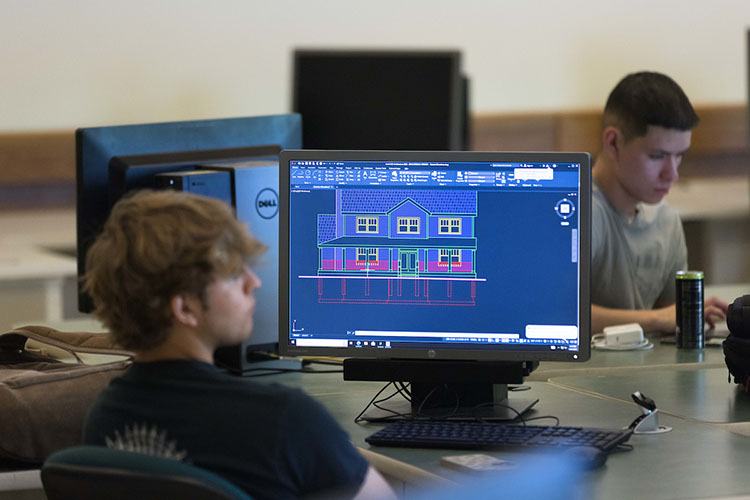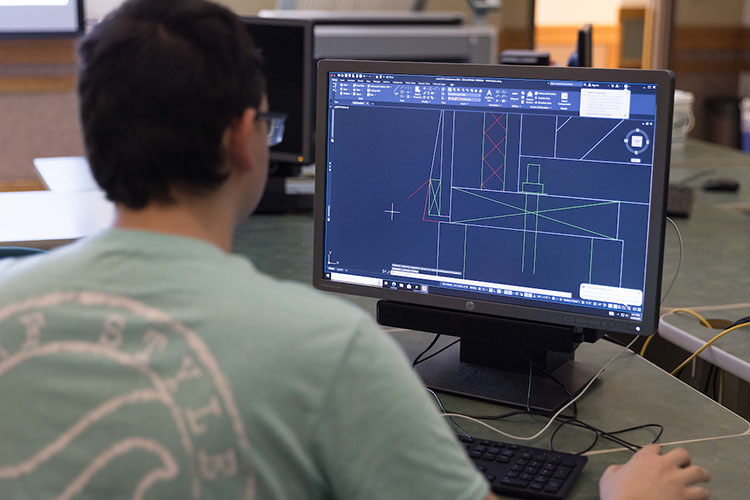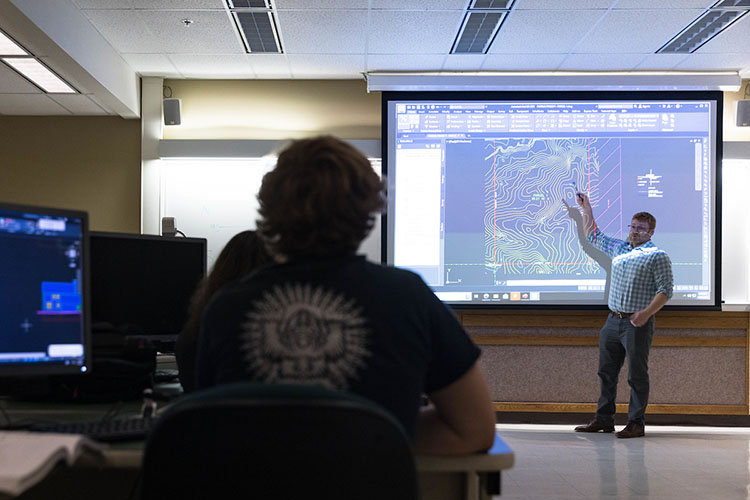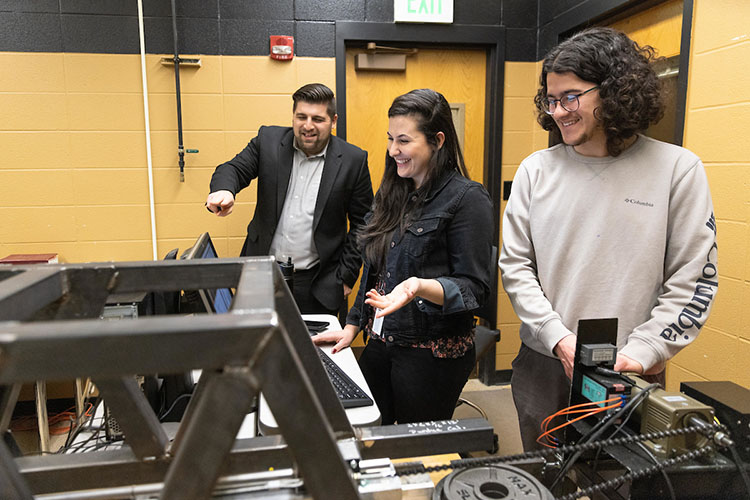What Can You Do with a Construction Management Degree?

Technology master’s student Maeve Bruna Cucolotto works on an in-lab bridge activity to assess the integrity of the structure.
Construction engineering and management technology (CEMT) is everywhere – the roads we drive on, the buildings we work in, the restaurants we eat at and even the hospitals where we seek medical care. CEMT is essential for not only new construction projects but also rehabbing existing structures and roadways.
This field encompasses a wide range of skills, including project management, planning and scheduling projects, estimating and financing project costs, and purchasing materials. It also requires the ability to build strong working relationships with engineers, architects, owners and subcontractors.
According to the U.S. Bureau of Labor Statistics, construction engineering and management technology careers are expected to grow 8 percent through 2031, faster than the national average for all occupations.
Learn more about how Purdue University Northwest’s Construction Engineering and Management Technology degree program can prepare you for a successful career in CEMT.
What is Construction Engineering and Management Technology?
CEMT is the management and oversight of construction projects. It blends technical knowledge and management skills to aid in a wide range of construction projects from roadways, high-rise buildings, bridges and infrastructure to commercial, residential and large-scale structures.

In the Construction Graphics introduction course, students learn how to read construction drawings by actually creating a set of architectural plans for a single-family home.
What are the Top Construction Engineering and Management Technology Careers?
Construction engineering and management technology offers a variety of career paths and positions. Some of the more common engineering and management technology positions are:
- Estimator: An estimator conducts an analysis and determines the overall cost of the project.
- Construction Manager: A construction manager runs the project. They are responsible for getting all subcontractors under contract; negotiating contracts; submitting requests for information to designers/architects; and handling change orders and payouts.
- Field Engineer: A field engineer is responsible for ensuring the project designs and parameters are being followed at the job site. They also conduct inspections and manage field activities.
- Superintendent: A superintendent is responsible for the day-to-day operations in the field. They create work schedules for construction team members and subcontractors, answer questions about the project, and monitor the project’s progress, making sure to stay on schedule.
- Surveyor: A surveyor is responsible for the correct placement of the project’s constructed items, roadways and buildings. They take and make exact measurements, determine property boundaries and interpret data on the terrain for the site of the project.
- CAD Drafter: A CAD drafter uses computer assisted design (CAD) software to create technical drawings from architect design plans.
I really appreciated the hands on experience I was able to obtain at PNW in the lab courses and field trips. Professors were always more than happy to help with any questions I had as well.
Do You Need a College Degree to Work in Construction Engineering and Management Technology?
A CEMT degree helps students develop a wide range of both technical and managerial skills. It also increases a graduate’s earning potential and opportunities for leadership roles while offering an accelerated path for career advancement and a big-picture understanding of everything that goes into a major construction project.
Why Choose PNW for a Degree in Construction Engineering and Management Technology?
The CEMT program at PNW is one of the longest established degree programs at PNW and continues to build on its proud history by adapting to current trends in the industry.
PNW’s unique program is a blend of both engineering basics and management principles. It connects the basic principles of construction engineering and management learned in the classroom with experiential learning modules, or hands-on, field-based learning. Lab courses and field trips provide opportunities for students to get a more in-depth understanding of topics.
Dedicated technology labs provide application-oriented learning experiences with real-world equipment, like Bluebeam and Procore contactor management software, making graduates career-ready and attractive to prospective employers. Teaching laboratories provide students with hands-on experience in construction scheduling and management, materials testing and soils and land surveying using the latest industry software and equipment.
Field trips and visits from industry professionals and leaders give a closer look into different aspects of the industry by providing students with access to various companies, job sites, the Union of Operating Engineers Local 150 and discussions about industry practices and trends.
“The uniqueness of our program is the overall exposure to the industry and industry involvement, hands-on training and practices and a caring group of faculty who treat the student’s success as their own,” says Chandramouli V. Chandramouli, department chair of Construction Science and Organizational Leadership at PNW.

A PNW student designs architectural plans in the Construction Graphics course in the College of Technology.
Does PNW Offer Hands-On Construction Experience?
Students earn actual experience completing a senior project in the fourth year of the program. The project allows students to use the knowledge and skills gained over the course of their studies in a real-world application. Past class projects include the construction of a hospital in Westville, the building of a casino in La Porte and the renovation, conversion and remediation on an historical building for the Cedar Lake Historical Society.
“The senior project is an important part of the CEMT program,” says Chandramouli. “It demonstrates the student’s ability to apply concepts, knowledge and skills learned throughout their course of studies to solve real-world problems. It also helps to have that hands-on experience when interviewing for a job.”
Tau Alpha Pi, the national honor society for engineering technology, and the Construction Club, which participates in national competitions, offer CEMT students at PNW a chance to get involved on campus and meet other students that share similar interests in the construction and engineering fields.
The senior project is an important part of the CEMT program. It helps to have that hands-on experience when interviewing for a job.
How do CEMT Students Find Internships?
PNW’s close proximity to the city of Chicago and a large industrial base in NWI offers students in the program a wide-range of opportunities for internships and employment in the construction engineering and management technology field. Students are highly sought after for internships by a variety of large to mid-sized companies in the surrounding area, including Walsh Group-Construction Management Services, Kiewit Corporation, ArcelorMittal USA, NIPSCO and Tonn and Blank Construction.
The majority of PNW’s CEMT students complete internships and are able to secure employment through these internships. Many of the upper level classes in the CEMT program are offered in the evening to accommodate student’s internship and work schedules.
PNW also offers a pathway for eligible students to earn a degree in Organizational Leadership and Supervision. The program is open to students who are currently union apprentices or graduates of a union apprenticeship and focuses on both leadership and construction management skills that are needed by today’s construction superintendents.

Don Duncan, continuing lecturer and practicing architect, leads a Construction Graphics course in the College of Technology.
What is the Projected Outlook for Careers in Construction Engineering and Management Technology?
The outlook for careers in CEMT in Northwest Indiana is bright. According to Chandramouli, infrastructure, bridges and work in the transportation sector are experiencing significant growth and with it the need for professionals in the construction industry.
Based on recent senior exit surveys, the most common job for a recent PNW graduate with a CEMT degree is project engineer followed by assistant superintendent, assistant project manager and surveyor.
Is PNW’s CEMT Program Accredited?
PNW’s CEMT program is accredited by the Accreditation Board for Engineering and Technology (ABET) both with the Applied and Natural Science Accreditation Commission (ANSAC) criteria and the Engineering Technology Accreditation Council (ETAC) criteria. This ensures the program is independently reviewed and meets the quality expectations for professions in the construction engineering and management technology field.

Picture Yourself at PNW
See how Purdue University Northwest’s Construction Engineering and Management Technology degree program and how it can prepare you for a successful career in CEMT.

